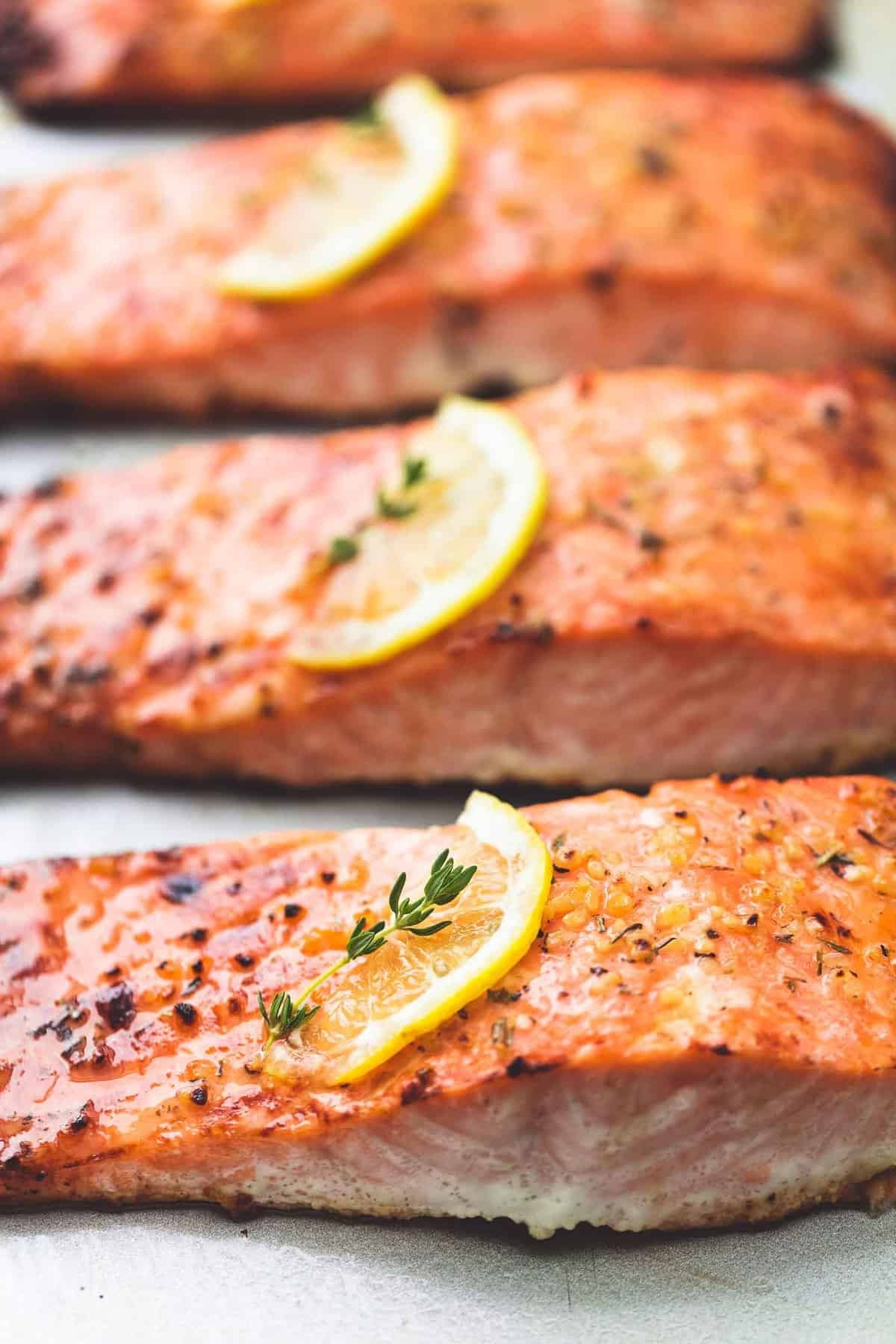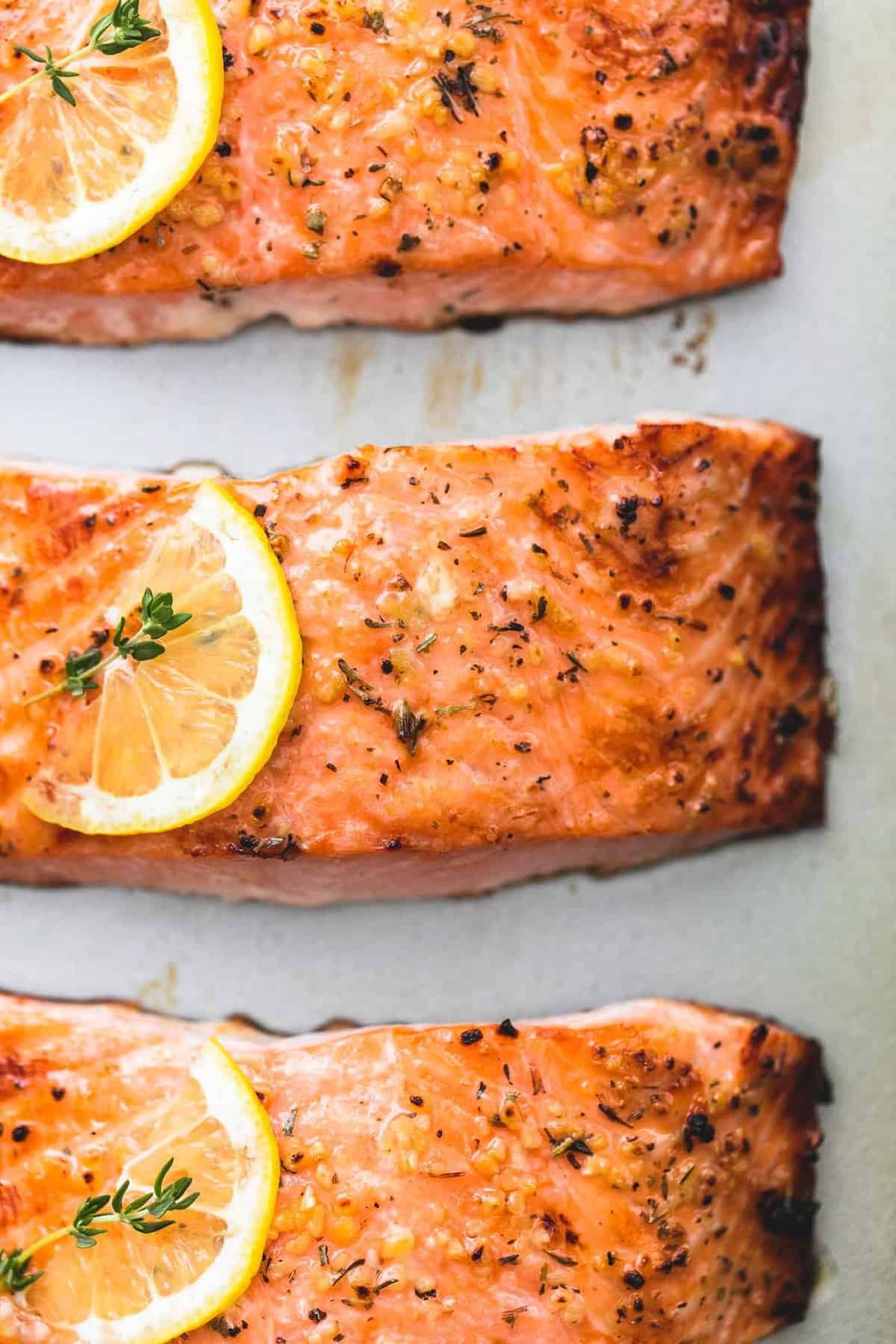Salmon is a beloved fish celebrated for its rich flavor and health benefits. Whether you’re a seasoned cook or a kitchen novice, mastering baked salmon is a valuable skill. Baking salmon is a simple and healthy method that yields incredibly tender and flaky results. But the most crucial question is, How Long To Cook Salmon to achieve that perfect texture without drying it out?
This guide will provide you with everything you need to know about baking salmon to perfection, ensuring it’s moist, flavorful, and cooked just right every time. We’ll cover cooking times, temperatures, helpful tips, and even a delicious and easy baked salmon recipe to get you started.
Understanding Salmon Cooking Time
The question of “how long to cook salmon” isn’t always straightforward. Several factors influence the ideal cooking time, including the thickness of the fillet, the oven temperature, and whether you are cooking fresh or frozen salmon. Overcooking is a common mistake that leads to dry, less enjoyable fish. Under-cooking, while less common, can pose health risks and result in an undesirable texture.
Generally, salmon cooks relatively quickly, which is one of its many advantages for a quick and healthy meal.
General Baking Times for Salmon at 400°F (200°C)
| Salmon Fillet Thickness | Approximate Cook Time |
|---|---|
| 1/2 inch (1.25 cm) | 8-10 minutes |
| 1 inch (2.5 cm) | 12-15 minutes |
| 1.5 inch (3.8 cm) | 15-20 minutes |



Note: These times are estimates and can vary based on your oven and the specific characteristics of the salmon. Always check for doneness using the methods described below.
Factors Affecting Salmon Cooking Time
Several variables can change how long you need to cook salmon. Paying attention to these factors will help you adjust your cooking time for the best results.
- Thickness of the Fillet: Thicker fillets will naturally require longer cooking times than thinner ones. Always measure your fillet at its thickest point to estimate the time.
- Oven Temperature Accuracy: Oven temperatures can fluctuate. Using an oven thermometer to ensure your oven is accurately preheated to 400°F (200°C) is recommended.
- Starting Temperature of Salmon: Salmon that is straight from the refrigerator will take slightly longer to cook than salmon that has been allowed to sit at room temperature for 15-20 minutes. However, for food safety, it’s generally recommended to cook salmon directly from the fridge.
- Fresh vs. Frozen Salmon: Frozen salmon should ideally be thawed before baking for even cooking. If you must bake frozen salmon, it will require significantly longer cooking time—approximately 50% more—and may release more moisture, potentially steaming rather than baking.
Step-by-Step Guide to Baking Salmon Perfectly
Now that we’ve addressed “how long to cook salmon” in general terms, let’s dive into a simple and delicious recipe for perfectly baked salmon. This recipe emphasizes ease and flavor, resulting in tender, flaky salmon every time.
Ingredients:
- 4 salmon fillets (about 6 ounces each), skin on or off
- 2 tablespoons olive oil
- ½ teaspoon salt, or to taste
- ¼ teaspoon black pepper, freshly cracked
- 2 teaspoons minced garlic
- 1 teaspoon Italian herb seasoning blend (or Herbs de Provence, or a mix of dried thyme, parsley, oregano, and basil)
- 1 medium lemon, halved
Instructions:
- Preheat the Oven and Prep: Preheat your oven to 400°F (200°C). Lightly grease a large baking pan or line it with parchment paper for easy cleanup.
- Prepare the Salmon: Arrange the salmon fillets on the prepared baking pan, leaving a little space between each fillet. Season generously with salt and freshly cracked black pepper.
- Make the Flavorful Sauce: In a small bowl, stir together the olive oil, minced garlic, Italian herb seasoning, and the juice from half of the lemon.
- Coat the Salmon: Spoon the garlic-herb mixture evenly over the salmon fillets. Ensure each fillet is well coated, rubbing the mixture over the tops and sides to prevent any dry spots during baking.
- Add Lemon Slices: Thinly slice the remaining half of the lemon. Place a lemon slice on top of each salmon fillet. This adds extra flavor and keeps the salmon moist.
- Bake to Perfection: Bake in the preheated oven for approximately 12-15 minutes for 1-inch thick fillets. Adjust the time according to the thickness of your salmon, using the guide above as a starting point.
- Check for Doneness: The salmon is done when it is opaque and flakes easily when gently pressed with a fork. You can also check the internal temperature with a meat thermometer; it should reach 145°F (63°C). For extra browning, you can broil for the last 1-2 minutes, watching carefully to prevent burning.
- Serve: Garnish with fresh thyme or parsley, if desired. Serve immediately and enjoy your perfectly baked salmon!
How to Tell When Salmon is Done
Knowing how long to cook salmon is important, but visually checking for doneness is equally crucial. Here are a few reliable methods to ensure your salmon is perfectly cooked:
- Flakiness: Salmon is done when it flakes easily when gently pressed with a fork. The muscle fibers should separate readily.
- Opaque Appearance: Raw salmon is translucent and reddish. As it cooks, it becomes opaque and pink. Cooked salmon should be opaque throughout, with no translucent center.
- Internal Temperature: The USDA recommends an internal temperature of 145°F (63°C) for cooked fish. Use a meat thermometer inserted into the thickest part of the fillet to check the temperature.
- Visual Cues: The white, albumin protein will start to seep out of the salmon when it’s cooked. While some albumin is normal, excessive amounts can indicate overcooking.
Tips for Moist and Flaky Baked Salmon
Achieving moist and flaky salmon is the goal. Here are some helpful tips to prevent dry salmon:
- Don’t Overcook: Overcooking is the primary culprit for dry salmon. Stick to the recommended cooking times and check for doneness regularly.
- Bake at the Right Temperature: 400°F (200°C) is a good temperature for baking salmon as it cooks it through without drying out too quickly.
- Use Olive Oil and Lemon: Coating the salmon with olive oil and lemon juice helps to keep it moist during baking and adds flavor.
- Consider Skin-On Salmon: Baking salmon with the skin on can help retain moisture. The skin also becomes crispy and flavorful.
- Avoid Overcrowding the Pan: Overcrowding can steam the salmon instead of baking it. Ensure there is space between fillets for proper air circulation.
Exploring Different Types of Salmon and Cooking Times
While the basic baking method remains consistent, different types of salmon can vary slightly in fat content and texture, which might subtly affect cooking times. The five main types of Pacific salmon are:
- Sockeye Salmon: Rich red color and lower in fat, may cook slightly faster.
- King (Chinook) Salmon: Highest in fat, very rich flavor, and can remain moist even if cooked slightly longer.
- Coho Salmon: Milder flavor, often a good balance of fat and texture, cooks similarly to the general guidelines.
- Pink Salmon: Smaller and leaner, often canned, cooks quickly and can dry out if overcooked.
- Chum Salmon: Often used for roe, leaner texture, requires careful cooking to avoid dryness.
For most recipes, including baked salmon, Coho or Sockeye are excellent choices readily available and provide great flavor and texture.
Health Benefits of Salmon
Beyond knowing how long to cook salmon, understanding its nutritional benefits makes it even more appealing. Salmon is packed with nutrients and is an excellent addition to a healthy diet.
- Omega-3 Fatty Acids: Salmon is one of the best sources of omega-3 fatty acids, which are crucial for heart health, brain function, and reducing inflammation.
- High-Quality Protein: Salmon is a complete protein, providing all essential amino acids needed for muscle building and repair.
- Vitamins and Minerals: It’s rich in B vitamins, potassium, selenium, and antioxidants.
- Lower in Saturated Fat and Calories: Compared to many red meats, salmon is lower in saturated fat and calories while being nutrient-dense.
Including salmon in your diet can contribute to lower cholesterol levels and support overall well-being.
Shopping Tips for the Best Salmon
Choosing high-quality salmon is the first step to a delicious meal. Here are some tips for shopping for salmon:
- Smell Test: Fresh salmon should have a mild, ocean-like scent, not a strong “fishy” odor.
- Appearance: Look for vibrant, moist flesh without brown spots or dryness. Avoid fillets that look pale or bruised.
- Fresh vs. Frozen: Both fresh and frozen salmon can be excellent. Frozen salmon is often frozen at peak freshness and can be a convenient and cost-effective option. Ensure frozen salmon is tightly sealed without freezer burn.
- Label Information: Check labels for terms like “color-added” if you prefer natural color. Ask your fishmonger for advice and sourcing information if available.
Storing and Reheating Cooked Salmon
If you have leftover baked salmon, proper storage and reheating are essential to maintain its quality and safety.
- Storing: Store cooked salmon in an airtight container in the refrigerator for 3-4 days.
- Reheating: Reheat salmon gently to prevent it from drying out. The oven or a stovetop pan are better options than microwaving. Add a splash of water or broth during reheating to maintain moisture. Reheat at a low temperature (around 250°F or 120°C) until just warmed through.
Conclusion
Mastering how long to cook salmon is key to enjoying this healthy and delicious fish. By understanding the factors that affect cooking time, following a simple recipe, and using the tips provided, you can consistently bake salmon to flaky, moist perfection. Whether it’s a quick weeknight dinner or a special occasion meal, baked salmon is always a great choice. So, preheat your oven and get ready to enjoy the best baked salmon you’ve ever made!